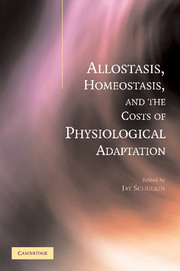Book contents
- Frontmatter
- Dedication
- Contents
- Preface
- Contributors
- Introduction
- 1 Principles of Allostasis: Optimal Design, Predictive Regulation, Pathophysiology, and Rational Therapeutics
- 2 Protective and Damaging Effects of the Mediators of Stress and Adaptation: Allostasis and Allostatic Load
- 3 Merging of the Homeostat Theory with the Concept of Allostatic Load
- 4 Operationalizing Allostatic Load
- 5 Drug Addiction and Allostasis
- 6 Adaptive Fear, Allostasis, and the Pathology of Anxiety and Depression
- 7 A Chronobiological Perspective on Allostasis and Its Application to Shift Work
- 8 Allostatic Load and Life Cycles: Implications for Neuroendocrine Control Mechanisms
- Commentary: Viability as Opposed to Stability: An Evolutionary Perspective on Physiological Regulation
- Index
5 - Drug Addiction and Allostasis
Published online by Cambridge University Press: 05 February 2015
- Frontmatter
- Dedication
- Contents
- Preface
- Contributors
- Introduction
- 1 Principles of Allostasis: Optimal Design, Predictive Regulation, Pathophysiology, and Rational Therapeutics
- 2 Protective and Damaging Effects of the Mediators of Stress and Adaptation: Allostasis and Allostatic Load
- 3 Merging of the Homeostat Theory with the Concept of Allostatic Load
- 4 Operationalizing Allostatic Load
- 5 Drug Addiction and Allostasis
- 6 Adaptive Fear, Allostasis, and the Pathology of Anxiety and Depression
- 7 A Chronobiological Perspective on Allostasis and Its Application to Shift Work
- 8 Allostatic Load and Life Cycles: Implications for Neuroendocrine Control Mechanisms
- Commentary: Viability as Opposed to Stability: An Evolutionary Perspective on Physiological Regulation
- Index
Summary
INTRODUCTION
Allostasis is a concept developed originally by neurobiologist Peter Sterling and epidemiologist James Eyer to explain the physiological basis for changes in patterns of human morbidity and mortality. They observed that the baby boom generation of individuals born after World War II had reached an age when major causes of death were renal, cerebral, and cardiovascular disease and that the single largest contributor to these diseases was hypertension. These researchers could find no explanation for these findings and no explanation for why hypertension was most prevalent where social disruption was greatest (Sterling and Eyer, 1988). They argued that the only possible link between the sociopsychological and physiological phenomena is in the brain. Using this backdrop, they argued for a form of brain-body regulation different from homeostasis, that of allostasis.
Homeostasis can be defined as “preserving constancy in the internal environment.” Allostasis can be defined as stability through change. Claude Bernard is credited with being the first to suggest that the internal milieu of the body is critically important for establishing and maintaining stable states within the body (this concept was later termed homeostasis by Walter Cannon in 1926). Bernard argued as early as 1859–60 that two environments affect an organism: a general milieu that is the outside world of inanimate and animate objects, and an internal milieu, where the elements of a living body find an optimal climate for operation. Originally described largely for the circulatory system, Bernard later argued for involvement of the lymphatic systems as well (Cannon, 1929, 1932, 1935).
Bernard further argued that not only was an organism required to respond to outside stimuli to regulate energy by bodily adjustments, but that the body also maintained the internal milieu remarkably constant in the face of such challenges making the organism at some level independent of the exterior challenges. Finally, he argued that all the vital mechanisms of the body have but one goal of maintaining the conditions of the life of the internal milieu constant (Cannon, 1929, 1932, 1935).
- Type
- Chapter
- Information
- Publisher: Cambridge University PressPrint publication year: 2004
- 8
- Cited by

